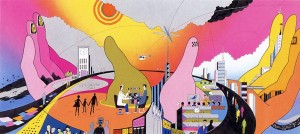As in the seventeenth century Galileo wrote “The Book of Nature is written in characters of Geometry“, so the Scottish biologist D’Ancy W. Thompson, almost four centuries later, undertook a study focused on the use of mathematics to describe what is still a recurring theme: the “evolution”. He pushed himself to the limits of research with the ambition to find a “scheme” of Nature (“On Growth and Form” published on 1917).
The chapter in point is “Comparison of the related Forms“, where Thompson, inspired by the work of the artist Albrecht Dürer, explores the degree to which differences in the forms of related animals could be described by means of relatively simple mathematical transformation.
After fixing (drawn) on a classical cartesian plane his study models (bones, skulls, fishes), he proceeded with linear transformations and affine transformations, rotations, reflections and translations, which were going to change the design of the basic model in a new design attributable to a different characteristics model, but of the same biological “family” (i.e. from the cannon-bone of ox to a cannon-bone of sheep).
Doing so he reported four different methods of deformation of the cartesian plane: transformation with linear function; logarithmic increase; when the rectangular coordinates become “oblique” and their axes have a Certain angle “w” and transformation to radial coordinates with one focus point.
Concisely, starting from a rigid mathematical and geometrical view, the biologist investigated new meanings of forms in nature trying to give them “mathematical names.”
As we have already seen for Rudofsky, the method of analysis and work is the same as the one used here by Thompson, ZOOM IN and ZOOM OUT, which we can compare, in affinity and practical significance, with the short film directed by Ray and Charles Eames (“Powers of Ten” – http://www.powersof10.com/film).
An holistic view is essential to issues such as Form and Nature, Science and Art, Human Being and Society.
In the class discussion we reflected on the meaning of Form and its “genesis”, about the two main structures identified by De Landa such as “Strata”, that is articulation of omogeneus element (omogenesis – bubbles or tree structure), and the “Self -consistent aggregates ” as articulation of heterogeneous elements (morphogenesis – embryo or ecosystem).
I found the text “Emergence” by S. Johnson particularly interesting. Starting from the analysis of a social system ants, he works up to the definition of “emergence” that it is refering to the ability of low-level components of a system or community to self-organize into a higher-level system of sophistication and awareness. Johnson notes that this self-reorganizing derives from the bottom up rather than directed by an external control factor. He presents five fundamental principles to support his hypothesis: more is different, ignorance is useful, encourage random encounters, look for patterns, pay attention to your neighbors. Another important point is the strength of connections that he calls “mega-organism” (city). He reflects on the so called “Side Walk” that is a set composed of all the main tools for communication and information, defined as an essential element in that mega-organism.
POSSIBLE PERSONAL RESEARCH:
“Big Data” and “the Third Industrial Revolution”: new craftsmen of the future!
Talking about the future, I believe that a return to the idea of handicraft is essential for the (r)evolution of our current welfare state. The new “craftsmen of the future” (us!) need to combine technology and tradition to give meanings and social values to products otherwise easily replicable.
Why not consider the use of new technologies (3D printing, laser cutter, etc.) first of all as tools to enable and stimulate a new generation of “conscious manufacturers”?
If we see this phenomenon in a ZOOM IN scale, the passion of “doing/making” is a great way to cultivate creativity. Whereas, moving in a ZOOM OUT scale, it is essential for a substantial evolution in the world of communications and exchange of ideas, smart cities, smart economy and for a development of the city and of the architecture itself (DIY-Architecture?).
* “if we ignore the motion, consequently we ignore the nature”
Cover Picture by Hiroshi Manabe

